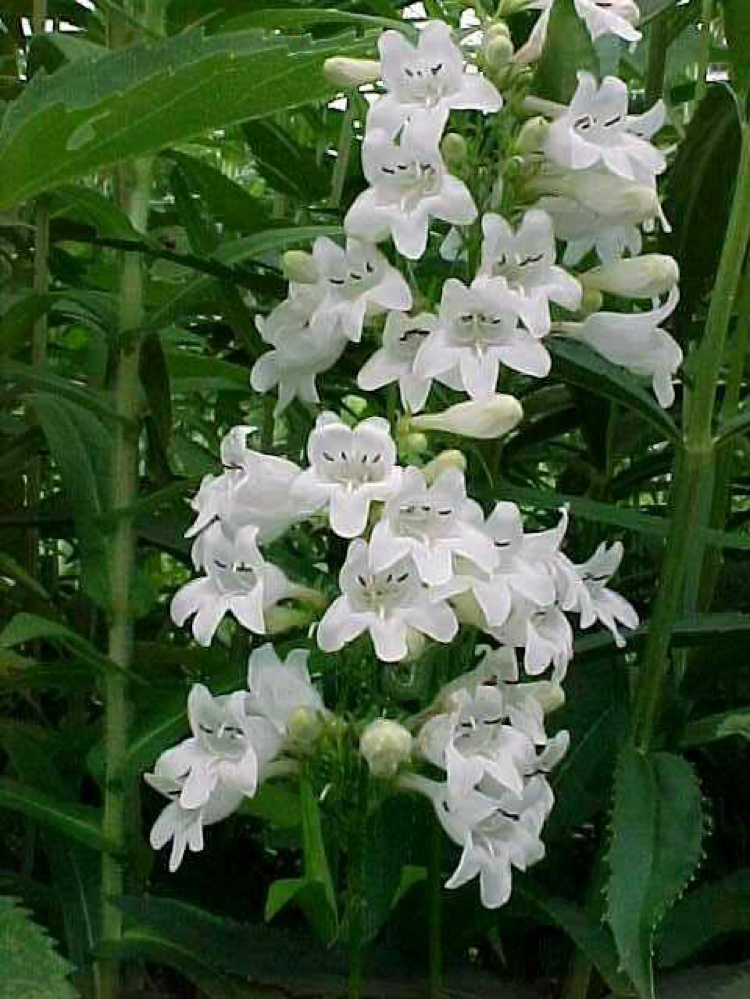Penstemon digitalis: Foxglove Beardtongue
 Latin name: Penstemon digitalis
Latin name: Penstemon digitalis
Common name: Foxglove Beardtongue, Smooth White Beardtongue 10
Flowers: White with purple lines in throat, one inch long flowers, and blooms for three months May – July10
Fruit: Tan color, inconspicuous10
Height & Width: 3ft -5ft tall, 1 1/2-2ft wide 10,12,19
Type: Herbaceous perennial10,12,19
Habit: Herb10,16 upright18
Wetland indicator category**: FAC17
Texture: Fine16
Growth rate: Fast19
Light: Full sun, part shade10,19
Moisture: Dry, moist, wet10
Soil*: Fertile, well drained loams, clay loam, sand, soil pH 5.5 – 7.010,16 can be grown in slightly alkaline and alkaline soils as well19
Zones: 3 to 812
Origin: Native to the lower 48 states16
Ecosystem benefits: Attracts birds, hummingbirds, butterflies and provides nectar10,12,19
Features: The flowers of this plant are both aesthetically pleasing and beneficial because they attract butterflies, bees, and hummingbirds. It is drought tolerant but also performs well in wet soils, making it an ideal plant for a rain garden12. Although the plant is short lived the showy foliage it provides has aesthetic value for the viewers20.
Siting: The plant is a great plant for places in yard that are clay loam soil and have poor drainage. This plant does well in a rain garden but will also tolerate dry shade10. In South Carolina it can be grown in the Upstate, Midlands, and Coast19.
Care: Plant crown at soil level18. At planting, water the roots and surrounding area slowly and deeply. Keep soil moist until plant is established, then apply enough water to thoroughly moisten the root zone when the soil is dry or during drought. Modify water recommendations to reflect site drainage and rainfall. Apply 3” of mulch over the planted area. Do not allow mulch to touch the plant stems18. For a cleaner appearance cut the bloom stalks once they have turned brown. Short lived and will need to be reseeded intermittently10.
Pests: Foxglove is tolerant of deer, and relatively pest resistant if culture preferences are met12.
This plant does not appear on the following invasive plant lists on (2/24/2019):
- USDA SC Invasive Plant Species Web site at http://www.invasivespeciesinfo.gov/plants/main.shtml
- SC Exotic Plant Pest Council Web site at http://www.se-eppc.org/southcarolina/
Author: Cy Gettliffe
Image source: http://www.missouribotanicalgarden.org/PlantFinder/FullImageDisplay.aspx?documentid=2511
Sources:
- Armitage, A. (2001). Armitage’s manual of annuals, biennials, and half-hardy perennials. Portland, OR: Timber Press.
- Armitage, A. (2006). Armitage’s native plants for North American gardens. Portland, Oregon: Timber Press.
- Armitage, A. (2008). Herbaceous perennial plants: A treatise on their identification, culture, and garden attributes. Athens, GA: University of Geogia.
- Clemson Cooperative Extension Home and Garden Information Center.(2011). Flowers fact sheets. Retrieved from https://hgic.clemson.edu/category/flowers/
- Clemson Cooperative Extension Home and Garden Information Center.(2011). Groundcovers & vines fact sheets. Retrieved from https://hgic.clemson.edu/category/groundcovers/
- Clemson Cooperative Extension Home and Garden Information Center.(2011). Trees. Retrieved from https://hgic.clemson.edu/category/trees/
- Clemson Cooperative Extension Home and Garden Information Center.(2011). Shrubs. Retrieved from https://hgic.clemson.edu/category/shrubs/
- Dirr, M. A. (2009). Manual of woody landscape plants. Champaign, IL: Stipes Publishing.
- Gilman, E. F. (1997). Trees for urban and suburban landscapes. Albany, NY: Delmar Publishers.
- Lady Bird Johnson Wildflower Center University of Texas at Austin. (2012). Native plant information network. Retrieved from http://www.wildflower.org/explore/
- McMillan, P., Plant taxonomist Clemson University, personal communication.
- Missouri Botanical Garden Kemper Center for Home Gardening. Plant finder. Retrieved from http://www.mobot.org/gardeninghelp/plantfinder/Alpha.asp
- North Carolina State University (2005). Plant fact sheets. Retrieved from http://www.ces.ncsu.edu/depts/hort/consumer/factsheets/index.html
- Strother, E. V., Ham, D. L., Gilland, L. (2003) Urban tree species guide: Choosing the right tree for the right place. Columbia, SC: South Carolina Forestry Commission.
- University of Florida, IFAS Extension. (2011). Southern trees fact sheet. Retrieved from http://edis.ifas.ufl.edu/department_envhort-trees
- USDA. Plant profile. (n/d).Retrieved from http://plants.usda.gov/java/
- USDA. Plant wetland indicator status. (n/d). Retrieved from http://plants.usda.gov/wetland.html
- Vincent, E., Environmental horticulturist Clemson University, personal communication.
- Clemson Extension. Carolina Yards Plant Database. Retrieved from https://www.clemson.edu/extension/carolinayards/plant-database/index.htm
- Gettliffe, C., Junior Student of Horticultural Clemson University, personal knowledge.
*Soil pH is determined using a professional soil test. Contact your Clemson University County Extension service for assistance www.clemson.edu/extension/. Click on “local offices”.
**2012 Plant Wetland Indicator categories (quantitative derived) http://plants.usda.gov/wetinfo.html
| Indicator Code | Indicator Status | Comment |
|---|---|---|
| OBL | Obligate Wetland | Almost always is a hydrophyte, rarely in uplands |
| FACW | Facultative Wetland | Usually is a hydrophyte but occasionally found in uplands |
| FAC | Facultative | Commonly occurs as either a hydrophyte or non-hydrophyte |
| FACU | Facultative Upland | Occasionally is a hydrophyte but usually occurs in uplands |
| UPL | Obligate Upland | Rarely is a hydrophyte, almost always in uplands |
